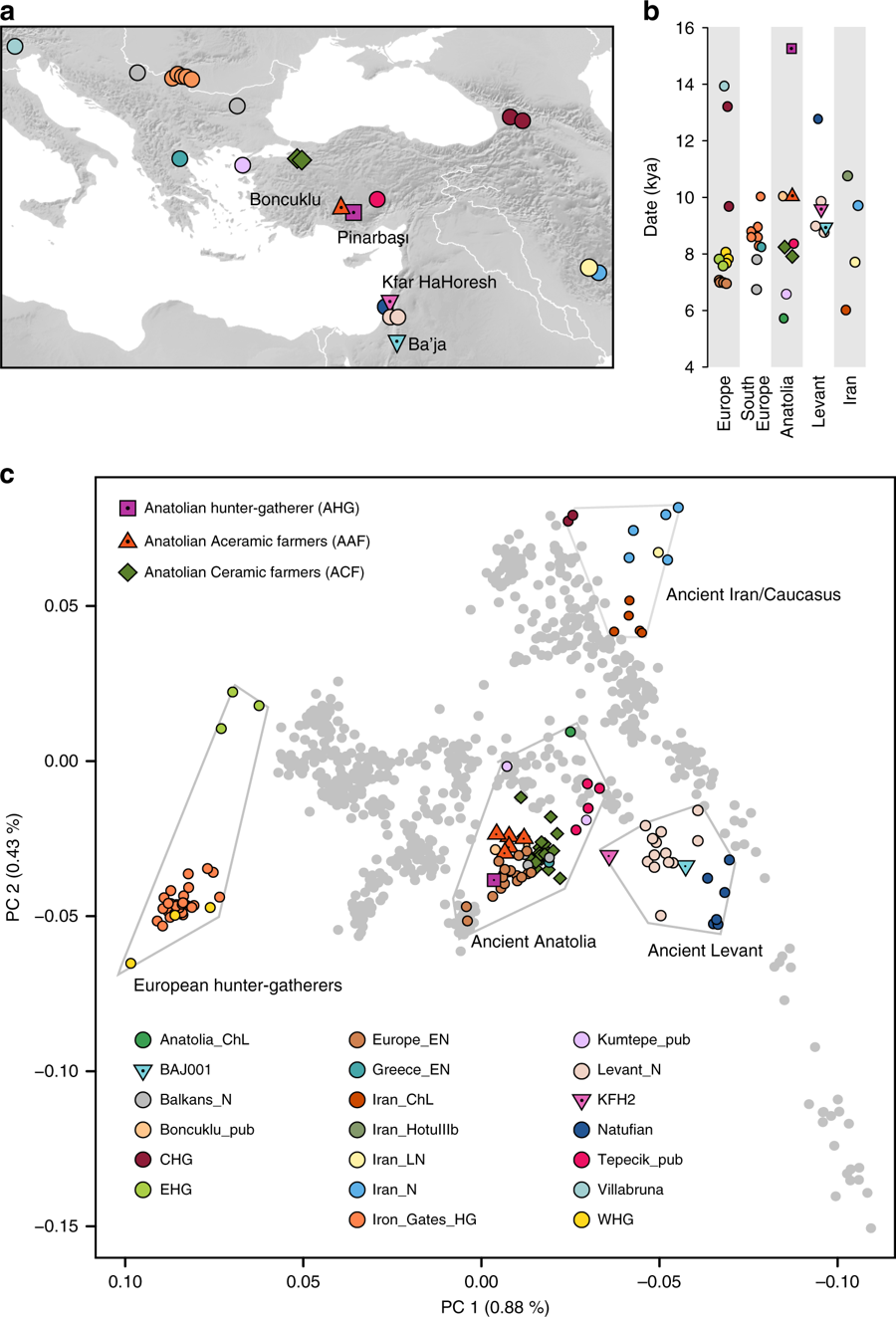EEF - pannous/hieros GitHub Wiki
EEF
Early European Farmers
https://en.wikipedia.org/wiki/Anatolian_hunter-gatherers
Anatolian hunter-gatherers (AHG) were a human Epipaleolithic population that inhabited central Anatolia around 13,642-13,073 BCE. This population constitutes the main ancestral genetic contribution of the present-day Europeans:
https://en.wikipedia.org/wiki/Early_European_Farmers bringing with them Neolithic inventions
This population is genetically differentiated from the rest of the known Pleistocene populations.
It has been discovered[1] that populations of the Anatolian Neolithic derive a significant portion of their ancestry from the AHG, suggesting that agriculture was adopted in situ by these hunter-gatherers and not spread by demic diffusion into the region.
The early European farmers carry much of the indigenous haplogroup I, as well as 'Georgian' haplogroup g. For example when Körös culture was analyzed, Of the two samples of Y-DNA extracted, one belonged to I2a2, and one belonged to G. When the Starčevo culture was analyzed in 2017, three belonged to subclades of G2a2, and two belonged to H2.
That makes a Semitic substratum of EEF less likely, but Semitic traits might still be carried in non patrial lineages from the Göbekli Tepe roots.
Despite of the Haplogroup signals, early European farmers seem to be not too far separated from Levantine influences/ancestors:

Do these three clusters correspond to the three 'tribes' in the Bible and to archaeological cultures?
The Kfar HaHoresh Individuum is of high significance, a PPNA regional funerary center connecting Tyre with Troy!
If the green Anatolian ChL Individuum turns out to be R1 it is a (representative) key figure in joining the distinct branch of Caucasian/Iranian ancestors.
Genome lives on, lineages died out:
The individual analyzed belongs to haplogroup C1a2 of the Y chromosome, which has been found in some of the early WHG's. It has also been observed that this individual belongs to the mitocondrial haplogroup K2b. Both paternal and maternal lineages are rare in the current Eurasian populations.
EEFs had initially spread agriculture throughout Europe largely without admixture with local WHGs.
At the onset of the Chalcolithic the picture becomes more complicated because of increased mobility.
During Late Neolithic and Bronze Age, a dramatic sex-bias was detected, suggesting heavy mixing between migrating males with steppe-related ancestry and local females with EEF ancestry. Not exclusive: increases in hunter-gatherer ancestry during the Middle Neolithic appeared to be largely the result of males with hunter-gatherer ancestry mixing with females with EEF ancestry. Middle Neolithic Europeans overwhelmingly carried hunter-gatherer paternal lineages and EEF maternal lineages. Hunter-gatherer ancestry was even higher among Late Neolithic samples from the Cucuteni–Trypillia culture, Funnelbeaker culture and Globular Amphora culture, which carried about 75-80% EEF ancestry while being dominated by hunter-gatherer paternal lineages.
Reflected in the tradition of traveling girls?
In the southern Balkans, the Middle Neolithic farmers display reduced levels of EEF ancestry increased amounts of ancestry related to Caucasian Hunter-Gatherers (CHGs), suggesting further gene flow from Anatolia, which continued into the Bronze Age.
During the Bronze Age Iberia experienced a significant genetic turnover, with 100% of the paternal ancestry and 40% of the overall ancestry being replaced by peoples with steppe-related ancestry.
A massacre of early Neolithic farmers in the high Pyrenees
EEF from Iberia almost entirely replaced the native Irish Hunter-Gatherers through a rapid maritime colonization. Peoples of the Irish and British Neolithic carried almost entirely the paternal haplogroup I-M284, suggesting that these societies were strongly patrilineal. A Neolithic royal buried at Newgrange was found to be highly inbred and possibly the product of an incestual relationship, suggesting that this community was highly socially stratified and dominated by a line of powerful "god-kings"
The First Temperate Neolithic (FTN) is an archaeological horizon consisting of the earliest archaeological cultures of Neolithic Southeastern Europe, dated to c. 6400–5100 BCE.[1] The cultures of the FTN were the first to practice agriculture in temperate Europe, which required significant innovations in farming technology previously adapted to a mediterranean climate.[2]
The constituent cultures of the FTN are:[1]
the Starčevo–Kőrös–Criș culture, encompassing:
the Starčevo culture, c. 6200–5200 BCE, Serbia, Bosnia, eastern Croatia and western Hungary;
the Kőrös culture, c. 6400–5100 BCE, eastern Hungary;
the Criş culture, c. 6400–5200 BCE, Romania;
the Karanova I/II culture, c. 6300–5100 BCE, central and southern Bulgaria;
the Macedonian First Neolithic, c. 6600–5300 BCE, North Macedonia;
the Poljanica group, c. 6300–5200 BCE, northeast Bulgaria;
and the West Bulgarian Painted Ware culture, c. 6200–5200 BCE, western Bulgaria.
Some of these cultures gave rise to the exceptional vinca culture, defining the hallmarks of the new Chalcolithic age: proto-writing, metallurgy and other inventions
Basque language isolate may be one of the rare surviving relatively closest proxies of Anatolian Farmers and early European farmers EEF. Genetically EEF is closest to modern Sardinians / Portuguese, but how about Basques themselves?
Gothic shows traces of the homogeneous language of EEF, with Basque as only known survivor:
to bite | kosk egin | 𐌺𐌰𐌿𐍃.𐌾𐌰𐌽 ( egin : goin/doin )